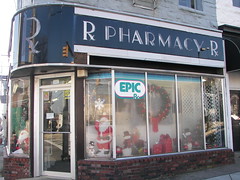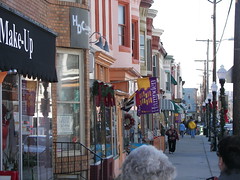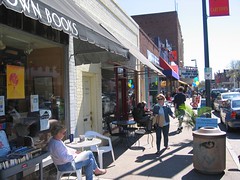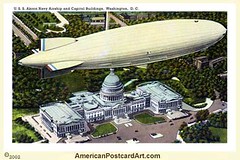The difficulties of urban Main Street programs
(USS Akron dirigible over the U.S. Capitol)
In honor of Labor Day...
1. In cities people have other choices. They aren't desperate for retail because they can go to another commercial district (or the suburbs) to shop, without major inconvenience. They don't have to roll up their sleeves and get to work to improve the local neighborhoood because they have no/few/distasteful alternatives. (My experience thus far with urban Main Street programs in DC is that the most active volunteers tend to live within two blocks of the the commercial corridor.)
In smaller communities, people must come together and work together to improve their community because relatively speaking, they have no alternative. Plus, there are local organizations like banks and newspapers that are place-specific businesses for whom success is dependent on the success of the locality.
In big cities, there are few banks that are locally based. And newspapers--which would rally around the local downtown via media coverage and editorials in smaller towns--are metropolitan. For example, even though the Washington Post is based in DC, its success isn't dependent on individual commercial districts but the region and in fact, DC is only the #4 market for the Post, after Fairfax, Montgomery, and Prince George's Counties.
(Note that one of the founders of what is the most successful Main Street program in DC, Barracks Row, is the chairman of one of the city's only neighborhood-based banks, the National Capital Bank, which has been located on Pennsylvania Avenue SE for at least 100 years.)
I have a copy of the front section of an edition of the Washington Times Herald from 1953, and it has more than 10 ads (some very large) featuring businesses located on H Street NE. Imagine that today. This communicates the centrality of the H Street commercial district as one of the leading shopping districts in the region before the rise of suburban shopping alternatives. Times have changed.
2. City vs. neighborhood issues. A city is large enough that it "doesn't have to care" when city policies don't work at the neighborhood district level. (Plus bureaucratic orientations and processes at the city-wide level have a tendency to be reproduced by the organizations and groups at the neighborhood level.)
It is much easier for a smaller town Main Street program to lobby and advocate for change so that the laws and regulatory policies of the community are congruent with the demands for commercial district revitalization.
For example, you can't have unique neighborhood street signs, street furniture, and streetlight poles, because the city standardizes these items across the city.
More importantly, different government agencies act in ways that don't support commercial district revitalization. (I.e. DC government land disposition and other construction projects are often performed in ways that further deconcentrate commercial business away from neighborhood business districts and promote what I call "intra-city sprawl." Other agencies have policies that are out of whack for the needs of local commercial districts. Of course, this is why commercial districts with capacity organize Business Improvement Districts, to help address these programmatic and bureaucratic deficits.
3. For a goodly number of months (before Robert Putnam's recent release of study results that find that social capital and community effects are reduced "with diversity" -- see "The downside of diversity," from the Boston Globe) I have been making the point that Main Street commercial district revitalization efforts are harder to realize in communities that are heterogeneous demographically. Neighborhoods tend to be more diverse in the center cities. (Also see the Clarence Page piece, originally from the Chicago Tribune, "Diversity is difficult, but worth the effort.")
That doesn't mean that it can't be done. Just that it is (or can be much) harder. E.g., the 14th and U Streets Main Street program dissolved over these kinds of issues. And in neighborhoods with changing demographics, change is difficult and contentious. (See the past blog entry "Commerz in the 'hood a/k/a Commerce as the Engine of Urbanism.")
But many of the successful urban Main Street neighborhoods and programs tend to be located in homogeneous, neighborhoods, where there is a clear majority of people of one ethnic group or race. See "Los Angeles's Black Pride," subtitled "Black Pride. Taking In the Retro Vibe of Leimert Park," from the Washington Post from May 2006. Places like Fruitvale in Oakland (Hispanic), or East Carson Street in Pittsburgh (ethnic white), also come to mind.
This drug store in Hampden, Baltimore is clearly not a chain--CVS, Walgreens, or Rite Aid--unlike most of the drug stores in DC. Also see "The Corner Drugstore, Barely Clinging to Health" from the Washington Post.

Hampden
4. Another problem is that real estate pricing in an urban neighborhood commercial district can be shaped by forces outside of the commercial district. E.g., in DC, marginal commercial districts have prevailing rents at rates that are unjustifiable by the amount of business generated within the commercial district.
The rents are based on factors related to DC as a strong commercial real estate market more generally, and especially the strength of the Central Business District and the market for office space around federal government functions.
This makes it very difficult to seed marginal commercial districtts with new and successful retail.
In other cities, with an excess inventory of available property, "marginal" uses (antique stores, used book and record stores, skate shops, etc.) can seed and revitalize commercial districts. It's no different than how the "arts" are used to seed revitalization--it's all about stimulating demand in places with excess supply. See "'Hoods With the Goods in Miami" from the Washington Post, which is about:
...the other Miami ... Away from the bright lights and hyperventilating crowds, in places where the casual tourist doesn't venture, is a dynamic mix of art, food and creativity. You won't need designer clothes or a VIP pass to navigate these up-and-coming neighborhoods.
Rents in successful neighborhood commercial districts in Baltimore and Richmond run about $18 to about $25/s.f. -- in successful places. In marginal districts in DC, the base asking rent is about $30/s.f. And the buildings tend to need a great deal of work to be successful retail venues--work that the property owner isn't likely to be interested in paying for. Even South Street in Philadelphia has prevailing rents that are much less when compared to most of DC's marginal commercial districts.
Carytown photo by Steve Pinkus.
Labels: civic engagement, commercial district revitalization, good government, government oversight, retail




0 Comments:
Post a Comment
<< Home